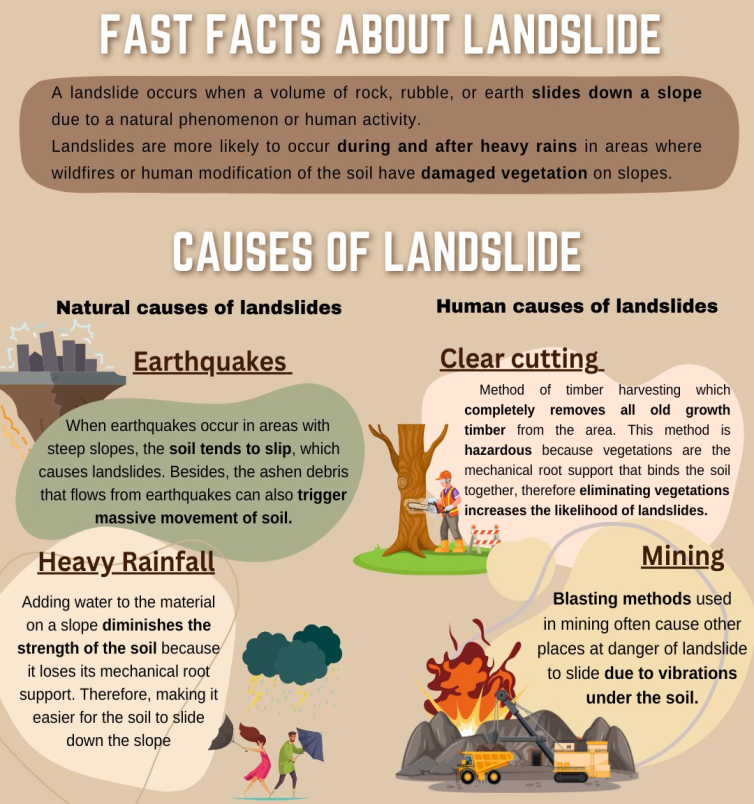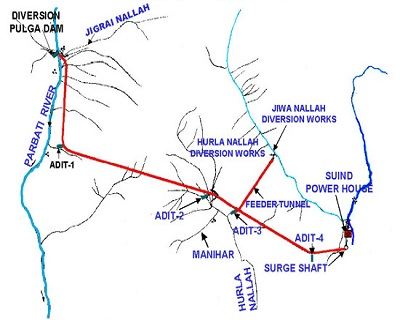Description

Copyright infringement not intended
Picture Courtesy: https://indianexpress.com/article/explained/explained-climate/northeast-mizoram-landslides-cyclone-remal-9358218/
Context: Cyclone Remal has caused landslides in the Northeast of India, causing at least 30 deaths and causing widespread damage.
Landslide Vulnerability
- Approximately 13% of India's landmass, spanning 15 states and four Union Territories, is prone to landslides. This vulnerability extends across hilly regions, with the Northeastern states being particularly susceptible due to their terrain. The region's susceptibility to earthquakes further exacerbates the risk of landslides, making it imperative to address multiple hazards simultaneously.
- Between 2015 and 2022, the Northeastern states recorded 378 major landslide events, resulting in loss of life and property damage. While Kerala saw the highest number of landslides overall, the Northeastern region's vulnerability is highlighted by the frequency and severity of landslide incidents.
- A National Landslide Risk Management Strategy finalized in 2019, outlined measures such as vulnerability mapping, early warning systems, and mountain zone regulations. However, implementation remains incomplete.
Landslides
- Landslides are the downward movement of rock, soil, and debris along a slope, often occurring suddenly and with destructive force. They can vary in scale from small, localised events to large, catastrophic occurrences that cause significant damage to infrastructure, property, and sometimes loss of life.
Causes of Landslides
Geological Factors
- Rock Type and Structure: Different types of rock have varying degrees of susceptibility to erosion and instability. For example, softer rocks like shale are more prone to weathering and erosion, increasing the likelihood of landslides.
- Slope Angle and Steepness: Steeper slopes are inherently more unstable and prone to landslides, especially when combined with other factors like soil saturation.
- Geological Faults and Fractures: Geological faults and fractures weaken the stability of rock formations, making them more susceptible to failure and triggering landslides.
Morphological Factors
- Weathering and Erosion: Weathering processes, such as freeze-thaw cycles or chemical weathering, can weaken rock and soil materials over time, increasing their susceptibility to landslides.
- Soil Type and Composition: The type and composition of soil play a crucial role in landslide susceptibility. Loose, unconsolidated soils like clay or silt are more prone to movement than cohesive soils like sand or gravel.
- Vegetation Cover: Vegetation helps stabilise slopes by binding soil and reducing erosion. Deforestation or vegetation removal can increase landslide risk by reducing slope stability.
Triggering Factors
- Heavy Rainfall: Intense or prolonged rainfall can saturate the soil and increase pore water pressure, reducing soil strength and triggering landslides. This is particularly common in areas with steep slopes and poor drainage.
- Earthquakes: Seismic activity can destabilise slopes by shaking or fracturing rock formations, leading to landslides. The intensity and duration of shaking, as well as the underlying geology, influence the likelihood of landslide occurrence.
- Human Activities: Construction activities, such as excavation or grading, can alter slope stability and trigger landslides. Similarly, deforestation, mining, and improper land use practices can increase erosion and weaken slopes, making them more susceptible to failure.

Types of Landslides
- Rockfalls: Rockfalls occur when individual rock fragments detach from a steep slope and free-fall or bounce downslope. They typically involve relatively small volumes of rock and can be triggered by factors such as weathering, seismic activity, or undercutting of the slope.
- Rockslides: Rockslides involve the rapid movement of large rock masses along a sloping surface. These events often occur on steep rock faces and are characterised by the detachment and sliding of intact rock masses.
- Debris Flows: Debris flows, also known as mudflows or lahars, consist of a mixture of water, mud, rock, and debris moving down a slope as a viscous, fast-flowing mass. They are commonly triggered by heavy rainfall or rapid snowmelt, which mobilises loose material and creates a slurry that flows downslope.
- Mudslides: Mudslides, also called mudflows or mudslides, involve the movement of saturated soil or regolith down a slope. They typically occur in areas with steep slopes and heavy rainfall, where water-saturated soil loses its cohesion and begins to flow downhill.
- Soil Creep: Soil creep is a slow, gradual movement of soil downslope due to gravity. It often occurs imperceptibly over long periods and is characterised by the gradual deformation of the soil and the tilting of trees, fences, or other structures on the slope.
Factors Contributing to Susceptibility
- Geological Instability: Geological factors such as the presence of weak rock formations, faults, fractures, and geological discontinuities can increase the susceptibility of slopes to failure.
- Steep Slopes: Steep slopes are inherently more prone to landslides, as gravitational forces act more strongly on sloping terrain, especially when combined with other factors such as geological instability or heavy rainfall.
- Heavy Rainfall and Saturation: Prolonged or intense rainfall can saturate soil and rock, reducing their strength and cohesion and increasing the likelihood of landslides.
- Deforestation and Land-Use Changes: Deforestation and land-use changes can alter the natural vegetation cover, reduce slope stability, and increase erosion rates, leading to heightened landslide susceptibility.
- Urbanisation and Construction Activities: Urbanisation and construction activities often involve excavation, grading, and alteration of the natural landscape, which can destabilise slopes and increase landslide risk.
- Mining and Excavation: Mining and excavation activities can weaken rock formations and alter the natural terrain, increasing the potential for slope instability and landslides.

Impacts of Landslides
- Loss of Life and Injuries: Landslides can result in fatalities, injuries, and trauma to individuals caught in their path or affected by the debris and destruction.
- Damage to Infrastructure: Landslides can damage roads, bridges, buildings, utilities, and other infrastructure, disrupting transportation networks, communication systems, and essential services.
- Displacement of Communities: Landslides can force the evacuation and displacement of communities living in hazard-prone areas, leading to temporary or permanent relocation and loss of livelihoods.
- Loss of Agricultural Land: Landslides can destroy agricultural land, crops, and irrigation systems, reducing food production and livelihood opportunities for affected communities.
- Environmental Degradation: Landslides contribute to soil erosion, sedimentation of water bodies, and loss of habitat, resulting in ecological disruption, biodiversity loss, and degradation of natural resources.
- Economic Losses: Landslides result in significant economic losses due to property damage, loss of infrastructure, disruption of services, and the cost of emergency response, recovery, and reconstruction efforts.
Mitigation Measures
Engineering Solutions
- Slope Stabilisation: Constructing retaining walls, gabion walls, and terracing to stabilise steep slopes. Installing rock bolts, soil nails, and mesh to reinforce unstable slopes and prevent soil movement.
- Drainage Control: Implementing surface water management techniques such as contour trenches, swales, and surface channels to divert water away from slopes. Installing subsurface drainage systems, including French drains and perforated pipes, to reduce soil saturation and groundwater pressure.
- Landslide Barriers and Catchment Structures: Installing debris flow barriers, catchment structures, and check dams to intercept and contain debris flow and sediment movement.
Vegetation and Ecosystem-Based Approaches
- Reforestation and Afforestation: Planting native vegetation on slopes to stabilise soil, reduce erosion, and enhance slope stability. Restoring degraded ecosystems to improve soil structure, increase water infiltration, and reduce landslide risk.
- Soil Conservation Measures: Implementing soil erosion control measures such as contour ploughing, mulching, and soil stabilisation techniques to minimise soil loss and erosion.
Land-Use Planning and Zoning Regulations
- Land-Use Planning: Implementing land-use zoning regulations to restrict development in landslide-prone areas and prioritise low-risk land uses. Conducting hazard mapping and vulnerability assessments to inform land-use planning decisions and development regulations.
Disaster Preparedness and Response Plans
- Early Warning Systems: Establishing early warning systems that utilise rainfall monitoring, weather forecasting, and slope monitoring to provide timely alerts for landslide risk.
- Emergency Response Plans: Develop contingency plans and evacuation procedures to respond effectively to landslide events and mitigate the impact on affected communities.
Community Engagement and Capacity Building
- Awareness Campaigns and Education Programs: Conduct public awareness campaigns to educate communities about landslide risks, warning signs, and safety measures. Providing training on disaster risk reduction, preparedness, and response to empower communities to take proactive measures.
- Stakeholder Engagement: Involving local communities, government agencies, NGOs, and other stakeholders in decision-making processes related to landslide risk management. Strengthening local governance structures and community organisations to enhance resilience and foster collective action.
Conclusion
- Landslides are a significant global geological hazard, causing significant loss of life and property. They can be caused by heavy rainfall, earthquakes, volcanic activity, erosion, or human activities. Mitigating landslides requires a multifaceted approach, including identifying susceptible areas, implementing land-use regulations, promoting sustainable practices, and investing in early warning systems.
Must Read Articles:
Cyclone Remul
Source:
Indian Express
Wikipedia
NCERT
|
PRACTICE QUESTION
Q. What are the socio-economic implications of recurrent landslides in highly populated areas like the hill stations of Uttarakhand and Himachal Pradesh, and how can these communities better prepare for and recover from such events?
|

















